Digital Twins In Healthcare Market Size
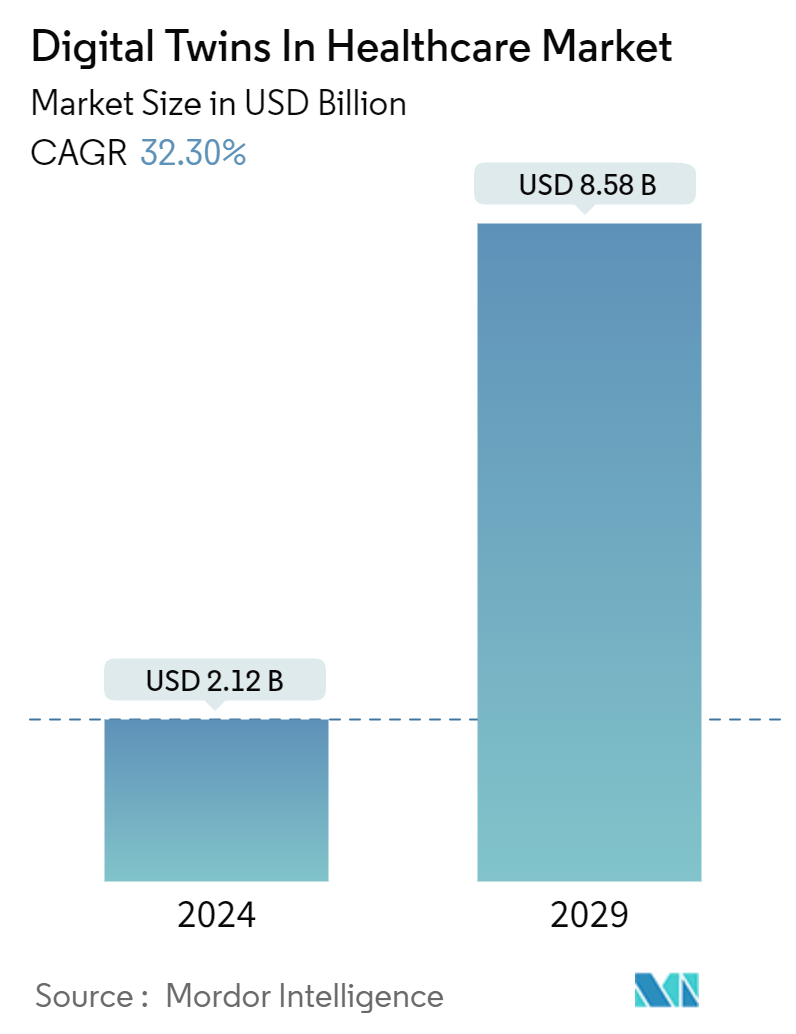
| Study Period | 2019 - 2029 |
| Market Size (2024) | USD 2.12 Billion |
| Market Size (2029) | USD 8.58 Billion |
| CAGR (2024 - 2029) | 32.30 % |
| Fastest Growing Market | Asia Pacific |
| Largest Market | North America |
Major Players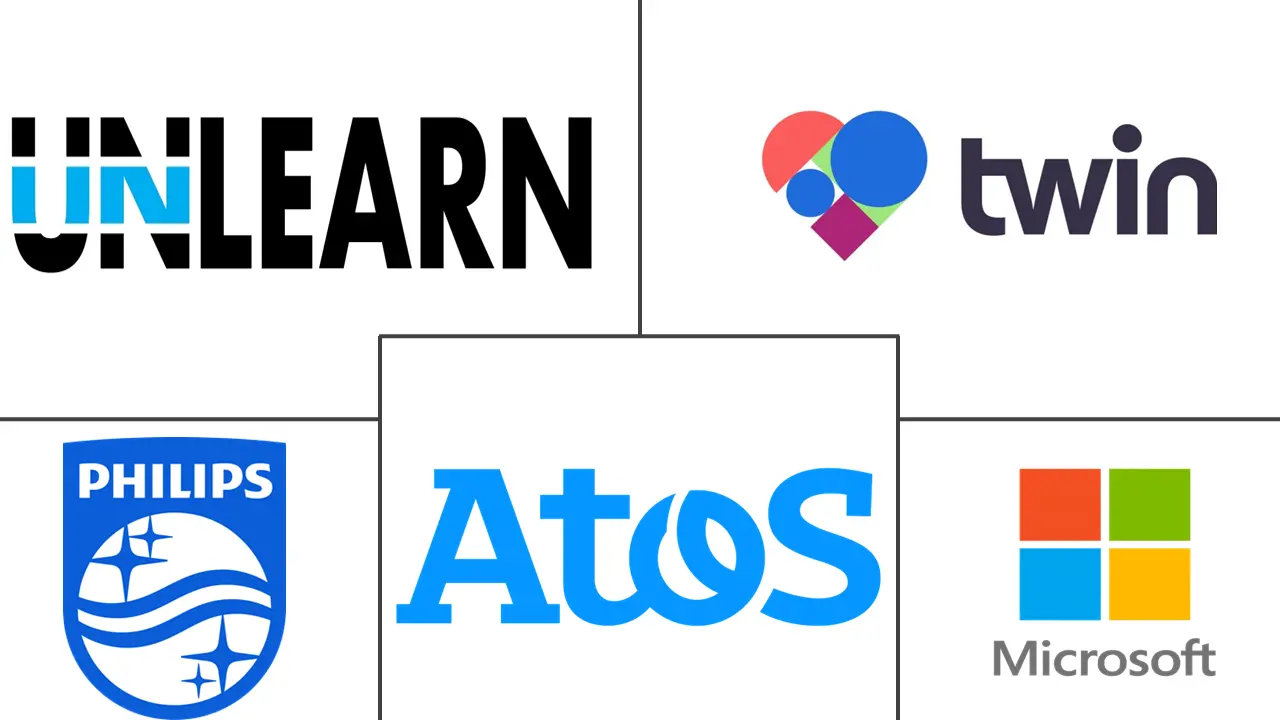
*Disclaimer: Major Players sorted in no particular order |
Digital Twins In Healthcare Market Analysis
The Digital Twins In Healthcare Market size is estimated at USD 2.12 billion in 2024, and is expected to reach USD 8.58 billion by 2029, growing at a CAGR of 32.30% during the forecast period (2024-2029).
The major factors driving the market are the growing investments in digital twin technology, the increasing adoption of digital twin technology, and rising advancements in artificial intelligence utilization in healthcare.
The growing investments in digital twin technologies can lead to the launch of new solutions, which are expected to increase the accessibility of digital twin technologies in healthcare and drive the market studied over the forecast period. For instance, in October 2023, the National Institutes of Health (NIH) awarded researchers from Cleveland Clinic and Metro Health a USD 3.14 million grant to use healthcare digital twins to better understand and address health disparities. Hence, such investments by government organizations are expected to accelerate the launch of new digital twins software in the healthcare sector, further driving the market studied over the forecast period.
Similarly, in December 2023, Twin Health, a metabolic care startup, reported that it had received USD 140 million in series C funding. The company is expected to use this funding to expand its whole-body twin technology, aimed at preventing and reversing metabolic disease. Hence, such huge investments by private venture capitalist firms are also expected to drive the market studied over the forecast period.
Furthermore, the increasing utilization of AI technologies and digital solutions in the healthcare sector is also expected to drive the market studied over the forecast period. For instance, according to an article published in Digital Medicine in March 2024, the rapid growth of big data and continuous advancement in data science (DS) and artificial intelligence (AI) in the healthcare sector have the potential to significantly accelerate digital twins research and development by providing scientific expertise, essential data, and robust cyber technology infrastructure. Hence, the high growth of artificial intelligence in the healthcare sector is expected to increase the adoption of digital twin technologies in healthcare, ultimately driving the market studied over the forecast period.
Moreover, increasing strategic activities such as mergers and collaborations by key players in the market to develop novel digital twin technologies are also expected to drive the market.
For instance, in December 2023, Quantum Genomics reported that it had entered exclusive negotiations for a merger with ExactCure, a French HealthTech company that develops medical devices based on a digital twin of the patient for the development of artificial intelligence device to tailor drug administration to each individual's profile. Similarly, in June 2023, QurAlis Corporation, a clinical-stage biotechnology company developing precision medicines for amyotrophic lateral sclerosis (ALS) and other neurodegenerative diseases, and Unlearn, a technology company, entered a collaboration to accelerate and optimize QurAlis' clinical program in ALS with Unlearn's advanced generative artificial intelligence (AI) technology.
In conclusion, the growing investments in digital twin technologies, the increasing utilization of AI technologies and digital solutions in the healthcare sector, and the increasing strategic activities of key players are expected to drive the studied market over the forecast period. However, the high implementation costs of digital twin technology, coupled with data management issues, are expected to restrain market growth over the forecast period.
Digital Twins In Healthcare Market Trends
Personalized Medicine Segment is Expected to Show Significant Growth During the Forecast Period
Personalized medicine is an emerging practice of medicine that uses an individual's genetic profile to guide decisions made regarding the prevention, diagnosis, and treatment of disease. Digital twins technology is integrated with vast amounts of data from wearable digital devices, omics, imaging, and electronic medical records, which helps in providing personalized medicine.
The various clinical advantages offered by digital twins in providing personalized medicine are expected to increase the adoption of digital twins technology in the healthcare sector, which will ultimately drive the studied market over the forecast period.
For instance, according to an article published in the Journal of Medicine Internet Research in May 2024, digital twins help personalized medicine across the understanding of patient health, risk assessment, and patient monitoring. By mirroring individual health profiles, digital twins offer unparalleled insights into patient-specific conditions, enabling more accurate risk assessments and tailored interventions. Hence, the crucial role of digital health in personalized medicine is expected to increase the demand for digital twin's software and services, driving the market studied over the forecast period.
Furthermore, increasing strategic activities, such as investment in startups, are also expected to drive the studied market over the forecast period. For instance, in October 2023, Mesh Bio, a Singaporean startup company that is focused on digital twin solutions for managing rising cases of chronic diseases, particularly in Southeast Asia, raised undisclosed funding from East Ventures to assist with its regional expansion. Hence, such strategic investments in startups are expected to increase the accessibility of digital twin solutions.
Thus, the various clinical advantages of digital twin solutions in personalized medicine and the increasing investments in digital twin technologies for providing personalized medicine for common diseases are expected to drive the market studied over the forecast period.
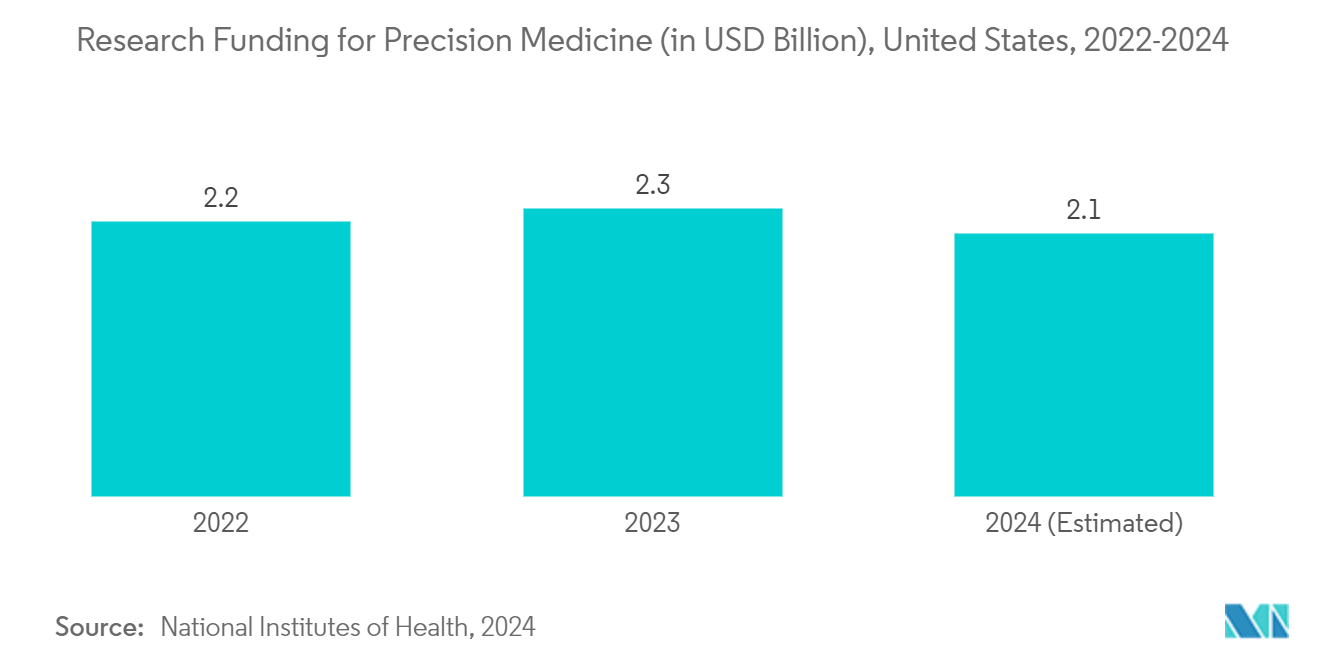
North America is Expected to Hold a Significant Market Share Over the Forecast Period
The geographical analysis of digital twins in the healthcare market shows that North America holds a significant market share in the global market. This is due to the increasing adoption of digital solutions in hospitals, advanced healthcare infrastructure, and increasing strategic activities by the key players.
The growing investment in the digitalization of the healthcare sector increases the utilization of digital twins technologies for individual’s existing health information in real-time and continually compares this data with the results from population studies, data on specific clinical pathologies, the course of specific diseases, and information on medications, diagnostics, and therapies used for other affected individuals.
For instance, in February 2022, the US Department of Health and Human Services (HHS), through the Health Resources and Services Administration (HRSA), awarded nearly USD 55 million to 29 HRSA-funded health centers to increase healthcare access and quality for underserved populations through virtual care such as telehealth, remote patient monitoring, digital patient tools, and health information technology platforms. Similarly, in July 2024, DIGITAL, Canada’s Global Innovation Cluster for digital technologies, reported an investment of USD 15.3 million in Canadian health tech companies and researchers to advance the development and deployment of AI-powered technologies to digitalize the healthcare system in Canada.
Hence, the increasing digitalization of the healthcare sector is expected to increase the adoption of digital twins in hospitals and drive the market studied over the forecast period.
Furthermore, the increasing investments in research activities for the development of new digital twin technologies in healthcare are also expected to drive the studied market over the forecast period.
For instance, in February 2024, Unlearn, a US-based AI-enabled company that provides digital twin technologies, raised USD 50 million in series C funding, bringing its total raise to more than USD 130 million. The company is expected to use this investment to grow its data and further invest in research and development initiatives and engineering capabilities. Hence, such investments are expected to increase the launch of new digital twin software, which will ultimately drive the studied market over the forecast period.
Hence, the growing investment in the digitalization of the healthcare sector and increasing research and development activities in North America are expected to drive the market studied over the forecast period.
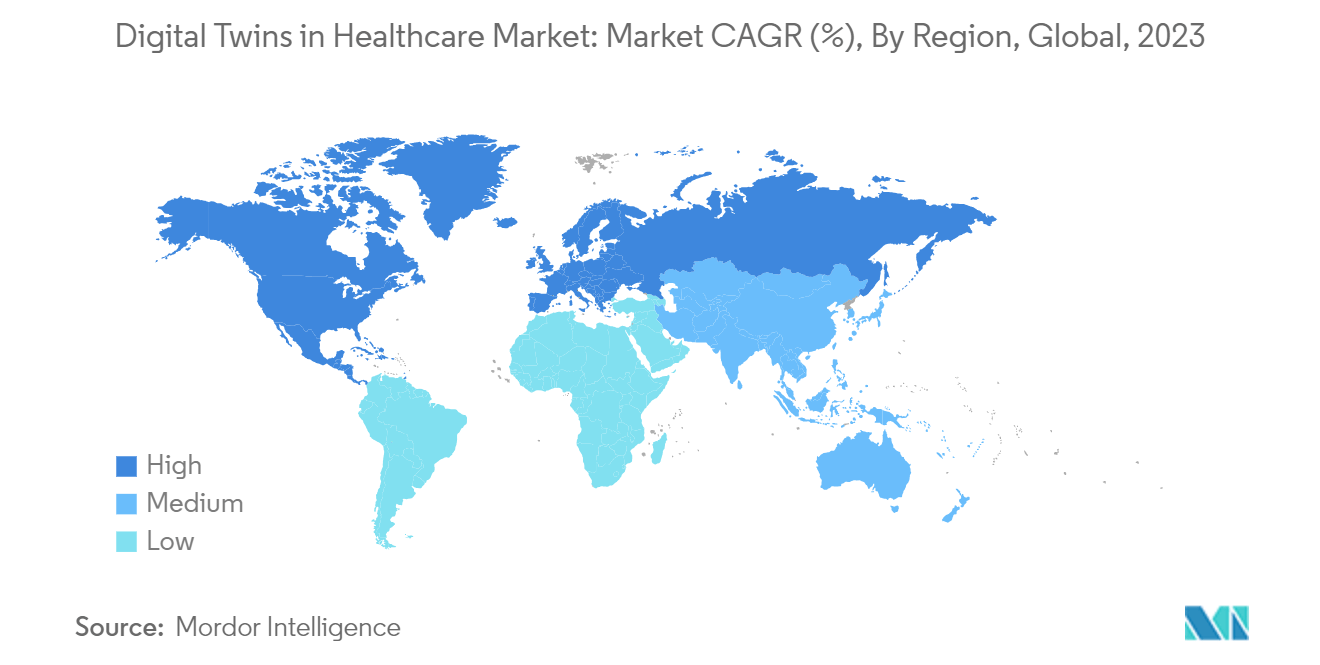
Digital Twins In Healthcare Industry Overview
The digital twins market in healthcare is fragmented due to the entry of new players and an increasing number of new startups in the field. With the increasing adoption of advanced healthcare technology worldwide, companies focus more on new digital twin software launches with novel features. Some well-known players in the market include Atos SE, Microsoft, Koninklijke Philips NV, Unlearn AI, and Twin Health.
Digital Twins In Healthcare Market Leaders
-
Atos SE
-
Microsoft
-
Koninklijke Philips N.V.
-
Unlearn AI
-
Twin Health
*Disclaimer: Major Players sorted in no particular order
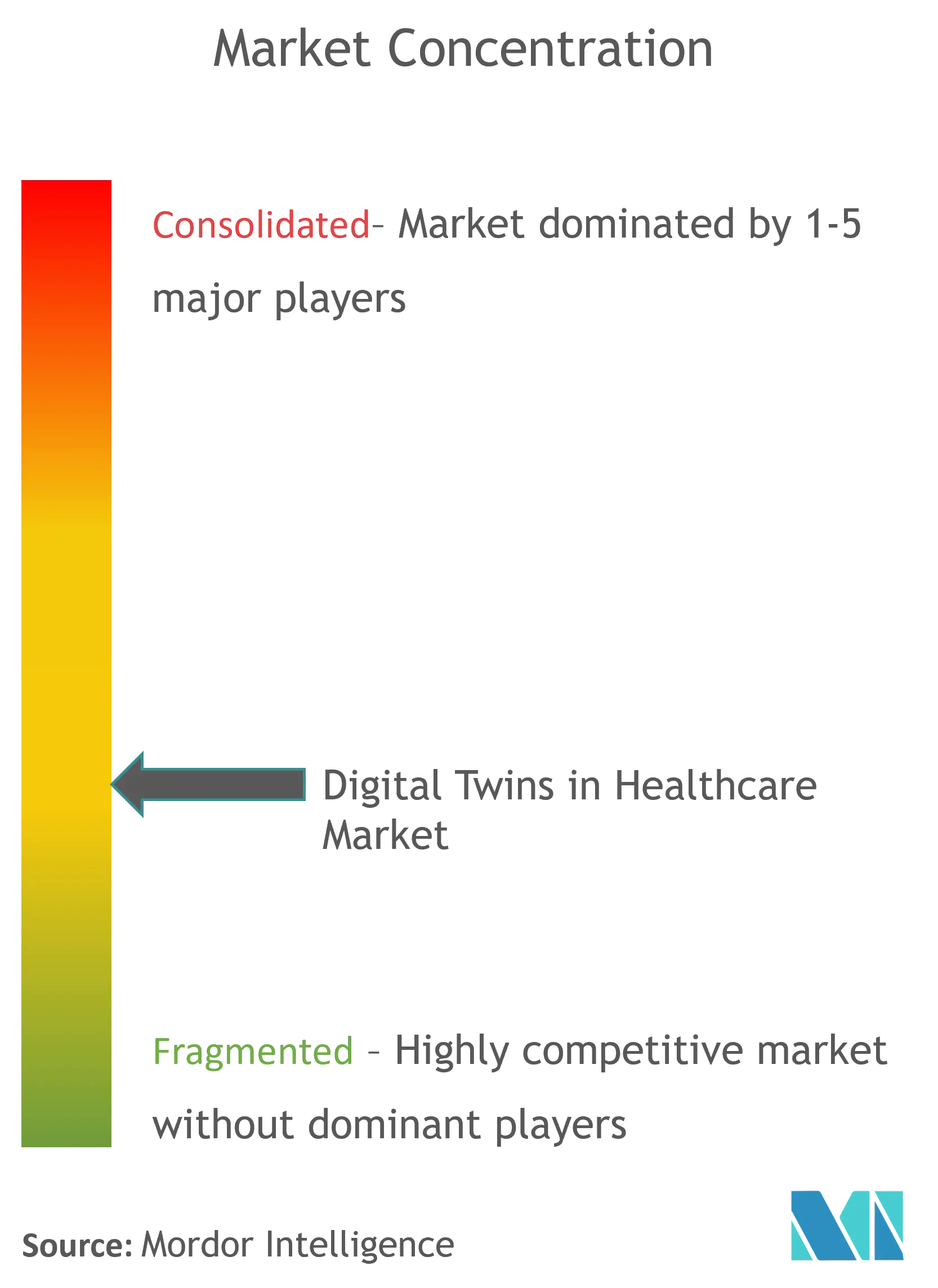
Digital Twins In Healthcare Market News
- May 2024: Twin Health, a healthcare technology company, launched its whole body digital twin AI platform to reduce reliance on GLP-1s and other costly health interventions for the treatment of type 2 diabetes and obesity.
- May 2024: Ontrak Inc., an AI-powered and technology-enabled healthcare company, reported the launch of its pioneering Mental Health Digital Twin (MHDT) technology. This digital twin technology is used to provide personalized, precise, and effective care for individuals struggling with mental health challenges.
Digital Twins In Healthcare Market Report - Table of Contents
1. INTRODUCTION
- 1.1 Study Assumption and Market Definition
- 1.2 Scope of the Study
2. RESEARCH METHODOLOGY
3. EXECUTIVE SUMMARY
4. MARKET DYNAMICS
- 4.1 Market Overview
-
4.2 Market Drivers
- 4.2.1 Growing Investments in Digital Twin Technology
- 4.2.2 Rising Advancements in Artificial Intelligence and Digital Solutions Utilization in Healthcare
-
4.3 Market Restraints
- 4.3.1 High Implementation Costs Digital Twin Technology Coupled With Data Management Issues
-
4.4 Porter's Five Force Analysis
- 4.4.1 Threat of New Entrants
- 4.4.2 Bargaining Power of Buyers/Consumers
- 4.4.3 Bargaining Power of Suppliers
- 4.4.4 Threat of Substitute Products
- 4.4.5 Intensity of Competitive Rivalry
5. MARKET SEGMENTATION (Market Size by Value - USD)
-
5.1 By Component
- 5.1.1 Software
- 5.1.2 Services
-
5.2 By Application
- 5.2.1 Drug Discovery
- 5.2.2 Medical Education
- 5.2.3 Workflow Optimization
-
5.3 By End User
- 5.3.1 Hospitals and Clinics
- 5.3.2 Clinical Research Organizations
- 5.3.3 Research and Diagnostics Laboratories
- 5.3.4 Other End Users
-
5.4 By Geography
- 5.4.1 North America
- 5.4.1.1 United States
- 5.4.1.2 Canada
- 5.4.1.3 Mexico
- 5.4.2 Europe
- 5.4.2.1 Germany
- 5.4.2.2 United Kingdom
- 5.4.2.3 France
- 5.4.2.4 Italy
- 5.4.2.5 Spain
- 5.4.2.6 Rest of Europe
- 5.4.3 Asia-Pacific
- 5.4.3.1 China
- 5.4.3.2 Japan
- 5.4.3.3 India
- 5.4.3.4 Australia
- 5.4.3.5 South Korea
- 5.4.3.6 Rest of Asia-Pacific
- 5.4.4 Middle East and Africa
- 5.4.4.1 GCC
- 5.4.4.2 South Africa
- 5.4.4.3 Rest of Middle East and Africa
- 5.4.5 South America
- 5.4.5.1 Brazil
- 5.4.5.2 Argentina
- 5.4.5.3 Rest of South America
6. COMPETITIVE LANDSCAPE
-
6.1 Company Profiles
- 6.1.1 Atos SE
- 6.1.2 Microsoft
- 6.1.3 Koninklijke Philips NV
- 6.1.4 PrediSurge
- 6.1.5 ThoughWire
- 6.1.6 Unlearn AI
- 6.1.7 Verto Healthcare
- 6.1.8 Q Bio
- 6.1.9 Dassault Systems (3DS System)
- 6.1.10 Faststream Technologies
- 6.1.11 Twin Health
- *List Not Exhaustive
7. MARKET OPPORTUNITIES AND FUTURE TRENDS
** Subject To AvailablityDigital Twins In Healthcare Industry Segmentation
As per the scope of the report, healthcare digital twins are described as virtual representations of patients that are created from multimodal patient data, population data, and real-time updates on patient and environmental variables.
The digital twins in the healthcare market are segmented into product, component, application, end-user, and geography. By component, the market is segmented into software and services. By application, the market is segmented into personalized medicine, drug discovery, medical education, and workflow optimization. By end-user, the market is segmented into hospitals and clinics, clinical research organizations, research and diagnostics laboratories, and others. By geography, the market is segmented into North America, Europe, Asia-Pacific, Middle East and Africa, and South America. The market report also covers the estimated market sizes and trends for 17 countries across major regions globally. The report offers values (USD) for the above segments.
| By Component | Software | |
| Services | ||
| By Application | Drug Discovery | |
| Medical Education | ||
| Workflow Optimization | ||
| By End User | Hospitals and Clinics | |
| Clinical Research Organizations | ||
| Research and Diagnostics Laboratories | ||
| Other End Users | ||
| By Geography | North America | United States |
| Canada | ||
| Mexico | ||
| By Geography | Europe | Germany |
| United Kingdom | ||
| France | ||
| Italy | ||
| Spain | ||
| Rest of Europe | ||
| By Geography | Asia-Pacific | China |
| Japan | ||
| India | ||
| Australia | ||
| South Korea | ||
| Rest of Asia-Pacific | ||
| By Geography | Middle East and Africa | GCC |
| South Africa | ||
| Rest of Middle East and Africa | ||
| By Geography | South America | Brazil |
| Argentina | ||
| Rest of South America |
Digital Twins In Healthcare Market Research FAQs
How big is the Digital Twins In Healthcare Market?
The Digital Twins In Healthcare Market size is expected to reach USD 2.12 billion in 2024 and grow at a CAGR of 32.30% to reach USD 8.58 billion by 2029.
What is the current Digital Twins In Healthcare Market size?
In 2024, the Digital Twins In Healthcare Market size is expected to reach USD 2.12 billion.
Who are the key players in Digital Twins In Healthcare Market?
Atos SE, Microsoft, Koninklijke Philips N.V., Unlearn AI and Twin Health are the major companies operating in the Digital Twins In Healthcare Market.
Which is the fastest growing region in Digital Twins In Healthcare Market?
Asia Pacific is estimated to grow at the highest CAGR over the forecast period (2024-2029).
Which region has the biggest share in Digital Twins In Healthcare Market?
In 2024, the North America accounts for the largest market share in Digital Twins In Healthcare Market.
What years does this Digital Twins In Healthcare Market cover, and what was the market size in 2023?
In 2023, the Digital Twins In Healthcare Market size was estimated at USD 1.44 billion. The report covers the Digital Twins In Healthcare Market historical market size for years: 2019, 2020, 2021, 2022 and 2023. The report also forecasts the Digital Twins In Healthcare Market size for years: 2024, 2025, 2026, 2027, 2028 and 2029.
Digital Twins In Healthcare Industry Report
Statistics for the 2024 Digital Twins In Healthcare market share, size and revenue growth rate, created by Mordor Intelligence™ Industry Reports. Digital Twins In Healthcare analysis includes a market forecast outlook for 2024 to 2029 and historical overview. Get a sample of this industry analysis as a free report PDF download.



